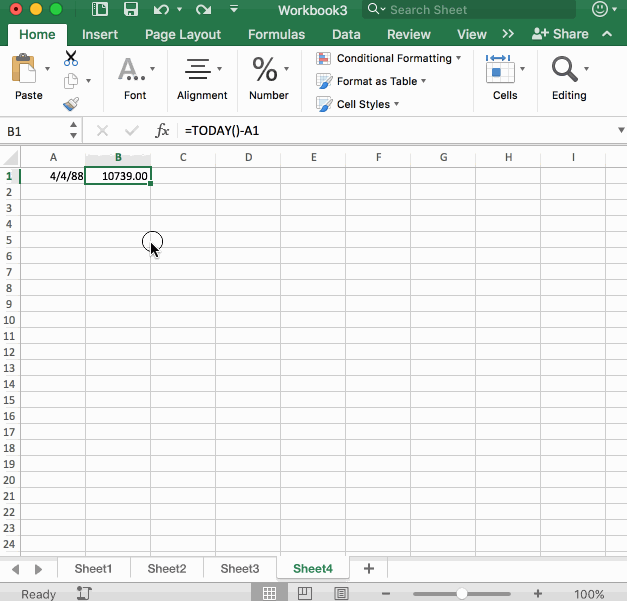How to Calculate Someone's Age in Excel
August 08, 2017
Calculating someone’s age in Excel should be pretty straightforward. You would think there was an Age() function in Excel, but unfortunately, we’re on our own to figure this one out. No worries, though, it’s not as bad as you might think.
Let’s get started.
The Problem
Say you have someone’s birthdate such as 4/4/1988. How would you go about
calculating their age?
You might say something like “easy, just take today’s date and subtract the birthdate.” Well, that’s a good starting point. Let’s work with that.
Assuming the birthdate is in A1, we’ll take today’s date (using the TODAY()
function) and subtract the birthdate:
=TODAY()-$A$1
=5/5/29 (May 5th, 1929)The result is May 5th, 1929? How did that happen?
How dates work in Excel
It’s important to take a second to explain how dates work in Excel. Put the
number 1 in a cell and convert it to a date. It will display 1/1/1900. This
is because dates in Excel start from 1/1/1900. If you changed the cell by
putting a 2 in there, the date would become 1/2/1900. What this means is
that each number represents how many days it has been since 1/1/1900.
Let’s look at the formula when we convert the dates into numbers.
=TODAY()-$A$1
=8/8/2017 - 4/4/1988
=42955 - 32237
=10718If you put the number 10718 in a cell and format it as a date you’d get
5/5/29.
But what does the number 10718 represent, anyway?
It actually represents the number of days between 4/4/1988 and 8/8/2017
(including leap days). So this person who has a birthdate of 4/4/1988 has
lived for 10,718 days. We can use this to figure out how many years they are.
We just need to divide by 365.25 (days in a year - including the fraction for
leap years).
To learn more about how dates work in Excel, check out this post.
Calculating Someone’s Age the Right Way
Let’s adjust the formula slightly
=(TODAY()-$A$1)/365.25
=29.3442847This person is 29 years old. The fraction portion represents how much of a
percentage of a new year they have lived. In our formula, this would be ~34%
of a new year, which translates to about 4 months. So 29 years and 4
months of age.
From here, we can either fix the number format to not include fractions or adjust the formula one last time:
=ROUND((TODAY()-$A$1)/365.25,0)And that’s how you calculate someone’s age in Excel.
But what if I want the EXACT Age?
What if you wanted to display someone’s age like the following:
29 years 5 months and 2 days oldHow can we do this?
Let’s say in A1 we have the following date:
4/4/1988In cell B1 we put the formula:
=TODAY()-A1And then we convert the cell to a number format we get:
10739What can we do with this?
Well, as an alternative to a special formula, we can use a Custom Number Format
for the cell B1.
Right-Click the cell B1 and select “Format Cell” then click on Custom and put
in the following:
y "years" m "months" d "days old"
In the custom number format, Excel understands when a number represents a date. We can use this to our advantage by utilizing the following custom number format info:
| Text | Meaning |
|---|---|
| y | Year - Excel will take the number and get the amount of years that number would represent if that number were treated as a serial number. |
| m | Month - Excel will figure out the amount of months (within a year) of the number if it were treated as a serial number. |
| d | Day - Excel determines the amount of days (within a month) of the number if it were treated as a serial number. |
To get a better understanding of how Excel Dates work, click here.
